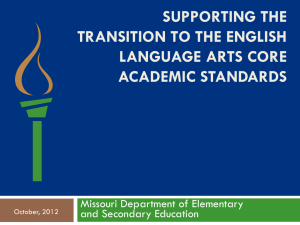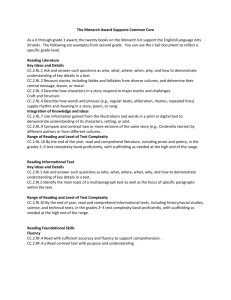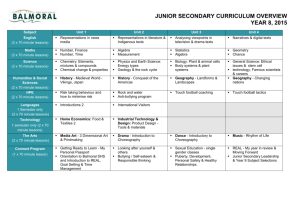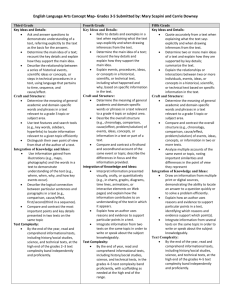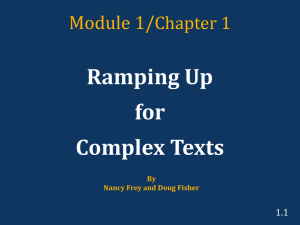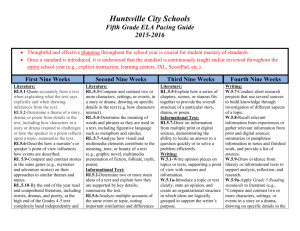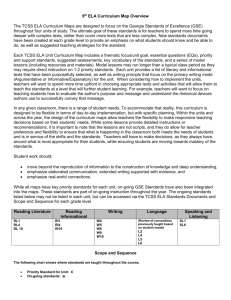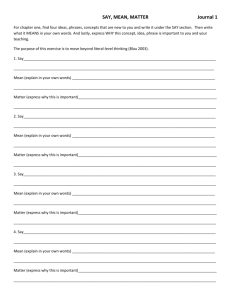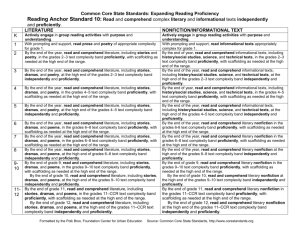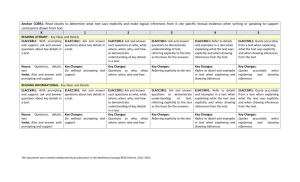CCSS Reading Literature
advertisement
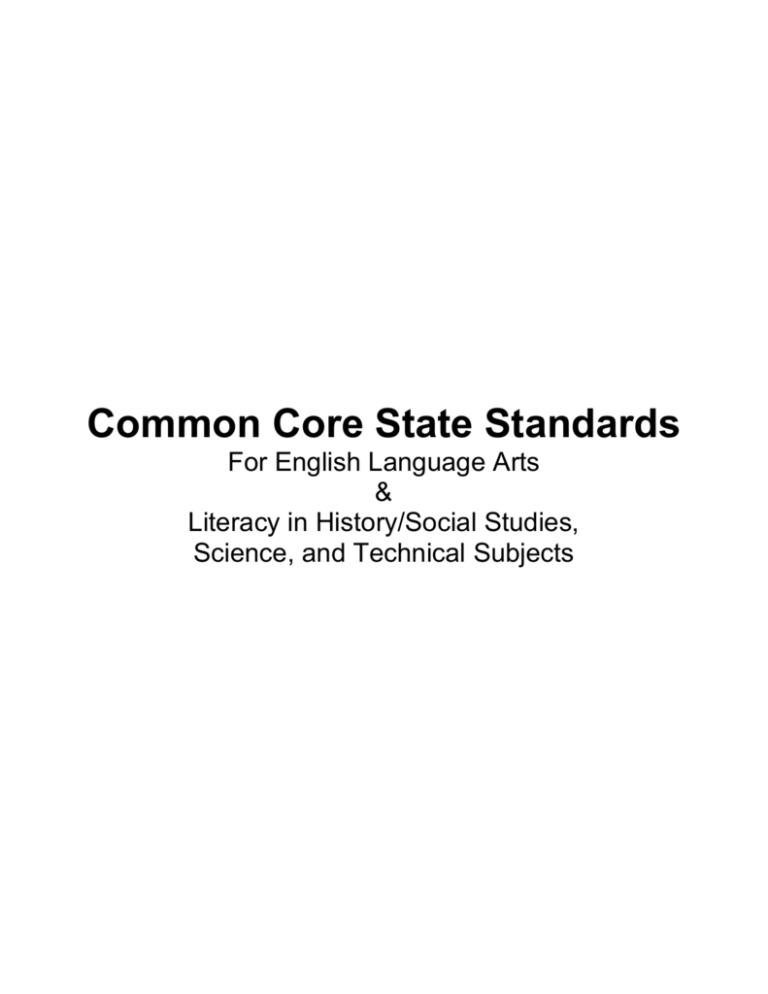
Common Core State Standards For English Language Arts & Literacy in History/Social Studies, Science, and Technical Subjects Reading Standards for Literature K–5 College and Career Readiness Anchor Standards for Reading The K–5 standards on the following pages define what students should understand and be able to do by the end of each grade. They correspond to the College and Career Readiness (CCR) anchor standards below by number. The CCR and grade-specific standards are necessary complements—the former providing broad standards, the latter providing additional specificity—that together define the skills and understandings that all students must demonstrate. Key Ideas and Details 1. Read closely to determine what the text says explicitly and to make logical inferences from it; cite specific textual evidence when writing or speaking to support conclusions drawn from the text. 2. Determine central ideas or themes of a text and analyze their development; summarize the key supporting details and ideas. 3. Analyze how and why individuals, events, and ideas develop and interact over the course of a text. Craft and Structure 4. Interpret words and phrases as they are used in a text, including determining technical, connotative, and figurative meanings, and analyze how specific word choices shape meaning or tone. 5. Analyze the structure of texts, including how specific sentences, paragraphs, and larger portions of the text (e.g., a section, chapter, scene, or stanza) relate to each other and the whole. 6. Assess how point of view or purpose shapes the content and style of a text. Integration of Knowledge and Ideas 7. Integrate and evaluate content presented in diverse media and formats, including visually and quantitatively, as well as in words.* 8. Delineate and evaluate the argument and specific claims in a text, including the validity of the reasoning as well as the relevance and sufficiency of the evidence. 9. Analyze how two or more texts address similar themes or topics in order to build knowledge or to compare the approaches the authors take. Range of Reading and Level of Text Complexity 10. Read and comprehend complex literary and informational texts independently and proficiently. *Please see “Research to Build and Present Knowledge” in Writing and “Comprehension and Collaboration” in Speaking and Listening for additional standards relevant to gathering, assessing, and applying information from print and digital sources. Note on range and content of student reading To build a foundation for college and career readiness, students must read widely and deeply from among a broad range of high-quality, increasingly challenging literary and informational texts. Through extensive reading of stories, dramas, poems, and myths from diverse cultures and different time periods, students gain literary and cultural knowledge as well as familiarity with various text structures and elements. By reading texts in history/social studies, science, and other disciplines, students build a foundation of knowledge in these fields that will also give them the background to be better readers in all content areas. Students can only gain this foundation when the curriculum is intentionally and coherently structured to develop rich content knowledge within and across grades. Students also acquire the habits of reading independently and closely, which are essential to their future success. 10 K-5 | Reading: Literature Common Core State Standards for ENGLISH LANGUAGE ART S & Literacy in History/Social Studies, Science, and Technical Subjects Reading Standards for Literature K–5 The following standards offer a focus for instruction each year and help ensure that students gain adequate exposure to a range of texts and tasks. Rigor is also infused through the requirement that students read increasingly complex texts through the grades. Students advancing through the grades are expected to meet each year’s grade-specific standards and retain or further develop skills and understandings mastered in preceding grades. Kindergarten Key Ideas and Details 1. With prompting and support, ask and answer questions about key details in a text. 1st Grade 1. Ask and answer questions about key details in a text. 2. With prompting and support, retell familiar stories, including key details. 2. Retell stories, including key details, and demonstrate understanding of their central message or lesson. 3. With prompting and support, identify characters, settings, and major events in a story. Craft and Structure 4. Ask and answer questions about unknown words in a text. 3. Describe characters, settings, and major events in a story, using key details. 5. Recognize common types of texts (e.g., storybooks, poems). 5. Explain major differences between books that tell stories and books that give information, drawing on a wide reading of a range of text types. 6. Identify who is telling the story at various points in a text. 6. With prompting and support, name the author and illustrator of a story and define the role of each in telling the story. 4. Identify words and phrases in stories or poems that suggest feelings or appeal to the senses. Integration of Knowledge and Ideas 7. With prompting and support, 7. Use illustrations and details in a describe the relationship between story to describe its characters, illustrations and the story in which they setting, or events. appear (e.g., what moment in a story an illustration depicts). 8. (Not applicable to literature) 8. (Not applicable to literature) 9. With prompting and support, 9. Compare and contrast the compare and contrast the adventures adventures and experiences of and experiences of characters in characters in stories. familiar stories. Range of Reading and Level of Text Complexity 10. Actively engage in group reading 10. With prompting and support, read activities with purpose and prose and poetry of appropriate understanding. complexity for grade 1. 11 2nd Grade 1. Ask and answer such questions as who, what, where, when, why, and how to demonstrate understanding of key details in a text. 2. Recount stories, including fables and folktales from diverse cultures, and determine their central message, lesson, or moral. 3. Describe how characters in a story respond to major events and challenges. 4. Describe how words and phrases (e.g., regular beats, alliteration, rhymes, repeated lines) supply rhythm and meaning in a story, poem, or song. 5. Describe the overall structure of a story, including describing how the beginning introduces the story and the ending concludes the action. 6. Acknowledge differences in the points of view of characters, including by speaking in a different voice for each character when reading dialogue aloud. 7. Use information gained from the illustrations and words in a print or digital text to demonstrate understanding of its characters, setting, or plot. 8. (Not applicable to literature) 9. Compare and contrast two or more versions of the same story (e.g., Cinderella stories) by different authors or from different cultures. 10. By the end of the year, read and comprehend literature, including stories and poetry, in the grades 2–3 text complexity band proficiently, with scaffolding as needed at the high end of the range. K-5 | Reading: Literature Common Core State Standards for ENGLISH LANGUAGE ART S & Literacy in History/Social Studies, Science, and Technical Subjects Reading Standards for Literature K–5 3rd Grade Key Ideas and Details 1. Ask and answer questions to demonstrate understanding of a text, referring explicitly to the text as the basis for the answers. 2. Recount stories, including fables, folktales, and myths from diverse cultures; determine the central message, lesson, or moral and explain how it is conveyed through key details in the text. 3. Describe characters in a story (e.g., their traits, motivations, or feelings) and explain how their actions contribute to the sequence of events. Craft and Structure 4. Determine the meaning of words and phrases as they are used in a text, distinguishing literal from non-literal language. 4th Grade 1. Refer to details and examples in a text when explaining what the text says explicitly and when drawing inferences from the text. 2. Determine a theme of a story, drama, or poem from details in the text; summarize the text. 3. Describe in depth a character, setting, or event in a story or drama, drawing on specific details in the text (e.g., a character’s thoughts, words, or actions). 5th Grade 1. Quote accurately from a text when explaining what the text says explicitly and when drawing inferences from the text. 2. Determine a theme of a story, drama, or poem from details in the text, including how characters in a story or drama respond to challenges or how the speaker in a poem reflects upon a topic; summarize the text. 3. Compare and contrast two or more characters, settings, or events in a story or drama, drawing on specific details in the text (e.g., how characters interact). 4. Determine the meaning of words and phrases as they are used in a text, including those that allude to significant characters found in mythology (e.g., Herculean). 5. Explain major differences between poems, drama, and prose, and refer to the structural elements of poems (e.g., verse, rhythm, meter) and drama (e.g., casts of characters, settings, descriptions, dialogue, stage directions) when writing or speaking about a text. 6. Compare and contrast the point of view from which different stories are narrated, including the difference between first- and third-person narrations. 4. Determine the meaning of words and phrases as they are used in a text, including figurative language such as metaphors and similes. 7. Make connections between the text of a story or drama and a visual or oral presentation of the text, identifying where each version reflects specific descriptions and directions in the text. 8. (Not applicable to literature) 9. Compare and contrast the treatment of similar themes and topics (e.g., opposition of good and evil) and patterns of events (e.g., the quest) in stories, myths, and traditional literature from different cultures. Range of Reading and Level of Text Complexity 10. By the end of the year, read and 10. By the end of the year, read and comprehend literature, including comprehend literature, including stories, dramas, and poetry, at the stories, dramas, and poetry, in the high end of the grades 2–3 text grades 4–5 text complexity band complexity band independently and proficiently, with scaffolding as needed proficiently. at the high end of the range. 7. Analyze how visual and multimedia elements contribute to the meaning, tone, or beauty of a text (e.g., graphic novel, multimedia presentation of fiction, folktale, myth, poem). 8. (Not applicable to literature) 9. Compare and contrast stories in the same genre (e.g., mysteries and adventure stories) on their approaches to similar themes and topics. 5. Refer to parts of stories, dramas, and poems when writing or speaking about a text, using terms such as chapter, scene, and stanza; describe how each successive part builds on earlier sections. 6. Distinguish their own point of view from that of the narrator or those of the characters. Integration of Knowledge and Ideas 7. Explain how specific aspects of a text’s illustrations contribute to what is conveyed by the words in a story (e.g., create mood, emphasize aspects of a character or setting). 8. (Not applicable to literature) 9. Compare and contrast the themes, settings, and plots of stories written by the same author about the same or similar characters (e.g., in books from a series). 12 5. Explain how a series of chapters, scenes, or stanzas fits together to provide the overall structure of a particular story, drama, or poem. 6. Describe how a narrator’s or speaker’s point of view influences how events are described. 10. By the end of the year, read and comprehend literature, including stories, dramas, and poetry, at the high end of the grades 4–5 text complexity band independently and proficiently. K-5 | Reading: Literature Common Core State Standards for ENGLISH LANGUAGE ART S & Literacy in History/Social Studies, Science, and Technical Subjects
